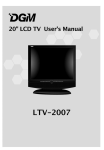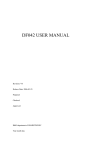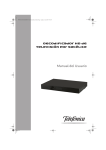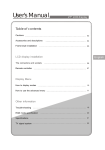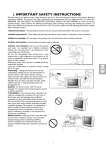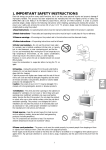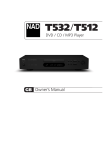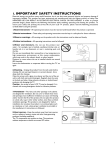Download Digimate LTV-2007 User's Manual
Transcript
English Contents ENGLISH ..............................................................................................................2 ◇COPYRIGHT .....................................................................................................1 ◇DISCLAIMER ....................................................................................................1 ◇FCC STATEMENT ............................................................................................1 FCC NOTICE ........................................................................................................1 Digimate LCD TV Series: B CLASS digital device........................................1 FCC CAUTION .....................................................................................................1 ◇FUNCTIONS AND FEATURES ........................................................................2 ◇SAFETY TIPS ...................................................................................................3 ◇IMPORTANT SAFETY INSTRUCTION ............................................................3 ◇CAUTION ..........................................................................................................4 ◇TIPS FOR CLEANING THE LCD DISPLAY.....................................................5 ◇PACKAGE CONTENTS....................................................................................6 Top View & Rear View ..................................................................................6 Front view......................................................................................................6 Accessories...................................................................................................7 Installation of batteries ..................................................................................7 ◇SETTING UP YOUR TELEVISION...................................................................8 AV and Antenna input Connection................................................................8 PC & Video Input Connection .......................................................................9 Power Connection.......................................................................................10 ◇TURNING YOUR LCD DISPLAY ON .............................................................10 ◇PROGRAMMING TV CHANNELS .................................................................10 ◇OPERATION USING THE CONTROLS ON THE LCD TV ............................11 ◇USING THE ADVANCED OSD MENU...........................................................12 ◇OSD MENUS AND OPTIONS (TV AND VIDEO MODE) ...............................13 ◇OSD MENUS AND OPTIONS (PC VIDEO MODE)........................................14 ◇OSD MENUS AND OPTIONS (PARENTAL CONTROL: FOR NTSC SYSTEM) ............................................................................................................................14 ◇V-CHIP: (NTSC TV ONLY) .............................................................................15 MAPP RATING ...........................................................................................15 TV RATING .................................................................................................15 ◇AUDIO .............................................................................................................16 ◇TROUBLESHOOTING....................................................................................17 TV................................................................................................................17 Antenna .......................................................................................................18 ◇SUPPORTED OPERATING MODES .............................................................20 ◇DIMENSIONAL DRAWINGS ..........................................................................21 ◇Copyright Copyright Digimate. All rights reserved. No part of this User's Manual may be reproduced, transmitted, transcribed, stored in a retrieval system or translated into any language or computer language, in any form or by any means, electronic, mechanical, magnetic, optical, chemical, manual or otherwise, without the prior written permission of Digimate. ◇Disclaimer Digimate makes no representations or warranties, either expressed or implied, with respect to the contents of this User's Manual. Digimate reserves the right to revise this publication and to make changes from time to time in the contents thereof without obligation to notify any person of such revision or changes. ◇FCC Statement FCC Notice Digimate LCD TV Series: B CLASS digital device This equipment has been tested and found to comply with the limits for a Class B digital device, pursuant to part 15 of the FCC Rules. These limits are designed to provide reasonable protection against harmful interference when the equipment is operated in a commercial environment. This equipment generates, uses, and can radiate radio frequency energy and, if not installed and used in accordance with the instruction manual, may cause harmful interference to radio communications. Operation of this equipment in a residential area is likely to cause harmful interference in which case the user will be required to correct the interference at his own expense. FCC CAUTION Pursuant to 47CFR, Part 15.21 of the FCC rules, any changes or modifications to this monitor not expressly approved by Digimate Corporation could cause harmful interference and would void the user's authority to operate this device. WARNING: This is a CLASS B product. In a domestic environment this product may cause radio interference in which case the user may be required to take adequate measures to counter interference. WARNING: To reduce the risk of fire and electric shock, do not expose this product to rain or moisture. 1 ◇Introduction Thank you for purchasing the Digimate LCD TV (Model LTV-2007). Your LCD TV will bring you years of high-quality viewing enjoyment. Your television is compatible with NTSC, PAL and SECAM systems, as well as the upcoming DTV standard. Your new Digimate television is extremely easy to operate, and has exceptionally high image quality. The LCD TV is also extremely versatile. You can install your television on the wall or set it on a table, and it can be used under any type of illumination. This manual will explain the operation of the LCD TV Model LTV-2007, including the set's functions and features and other important information. Before installing or operating your Model LTV-2007, please take the time to thoroughly read this manual, particularly the sections on safety! ◇Functions and Features The LCD TV Model LTV-2007 has many useful functions, including: 640 x 480 for 20” TV internal resolution Brightness and Contrast ratio: refer to the Function Specification Compatibility with all digital television (DTV) formats (with external tuner), Including 1080i, 720p, 480p, 2D digital comb filter, De-Interlacing, Multiple image formats for diverse viewing conditions Shortcut buttons: 1 Multi-Channel Television Sound (MTS) (Nicam) 2 Sleep timer 3 Back light adjustment 4 Auto Calibration 5 Aspect Ratio Adjustment 6 Graphic OSD ◇Important Information WARNING: TO REDUCE THE RISK OF FIRE OR ELECTRIC SHOCK, DO NOT EXPOSE THIS PRODUCT TO RAIN OR MOISTURE. WARNING: FCC Regulations state that any unauthorized changes or modifications to this equipment not expressly approved by the manufacturer could void the user's authority to operate this equipment. (U.S.A. ONLY) CAUTION: TO PREVENT ELECTRIC SHOCK, MATCH WIDE BLADE OF PLUG TO WIDE SLOT, FULLY INSERT. 2 The exclamation point within a triangle is intended to alert the user to the presence of important operating and maintenance (servicing) instructions in the literature accompanying the product. The lightning flash with arrowhead symbol within a triangle, alerts the user to the presence of uninsulated "dangerous voltage" within the product's enclosure that may constitute a risk of electric shock. Note to CATV system installer: This reminder is provided to call the CATV system installer's attention to Article 820-40 of the National Electrical Code that provides guidelines for proper grounding and, in particular, specifies that the cable ground shall be connected to the grounding system of the building, as close to the point of cable entry as practical.” ◇Safety Tips Please read and follow these safety tips to ensure the equipment is free from damage, and to ensure that no injury will occur as a result of improper use. ĆDo not insert any object (especially metal) or liquids, into the TV. ĆDo not place any objects containing water or any other liquid on top of the TV. ĆDo not place the unit in direct sunlight, near heaters or in extremely dusty or humid locations. ĆDo not install this system outdoors or otherwise expose it to the elements. ĆDo not place heavy objects on top of the TV. ĆIf the power cord is damaged or frayed in any way, electrical shock and/or fire may result. ĆPlease do not place objects on the power cord, and keep the cord away from heat-emitting devices. Should the power cord become damaged in any way, please contact your dealer for a replacement cord. ĆDo not remove the cover of the TV for any reason. If any problems arise with the unit, please contact your dealer for service. Removing the covers will void the warranty. ◇Important Safety Instruction 1 2 3 4 5 6 7 Read these instructions before the product is operated. Keep these instructions in a safe place for future reference. Heed all warnings. Follow all instructions. Do not use this apparatus near water. Clean only with dry cloth. Do not block any ventilation openings. Install in accordance with the manufacturer's instructions. 8 Do not install near any heat sources such as radiators, heat registers, stoves, or other apparatus (including amplifiers) that produce heat. 9 Do not defeat the safety purpose of the polarized or grounding type plug. A polarized plug has two blades with one wider than the other. A grounding type plug has two blades and a third grounding prong. The wide blade or the third prong is provided for your safety. If the provided plug does not fit into your outlet, consult an electrician for replacement of the obsolete outlet. 10 Protect the power cord from being walked on or pinched particularly at plugs, convenience receptacles, and the point where they exit from the apparatus. 11 Only use attachments/accessories specified by the manufacturer. 12 Use only with the cart, stand, tripod, bracket, or table specified by the manufacturer, or sold with the apparatus. When a cart is used, use 3 caution when moving the cart/apparatus combination to avoid injury from tip-over. 13 Unplug this apparatus during lightning storms or when unused for long periods of time. 14 Refer all servicing to qualified service personnel. Servicing is required when the apparatus has been damaged in any way, such as power-supply cord or plug is damaged, liquid has been spilled or objects have fallen into the apparatus, the apparatus has been exposed to rain or moisture, does not operate normally, or has been dropped. 15 Apparatus shall not be exposed to dripping or splashing and no objects fill with liquids, such as vases, shall be placed on the apparatus. 16 To reduce the risk of electric shock, do not remove cover (or back). No user-serviceable parts inside. Refer servicing to qualified service personnel. 17 The readily operable appliance coupler will serve as the disconnect device of this apparatus. 18 The apparatus must be connected to a mains socket outlet with a protected earthing connection. 19 Keep 10cm minimum distance around the apparatus for sufficient ventilation. 20 Spent or discharged batteries must be recycled or disposed of properly in compliance with all applicable laws. For detailed information, contact your local county solid waste authority. 21. Please change to appropriate power cord complied with local regulation when the LCD Display purchased and utilized at different nations. ! ! ! The lightning flash with arrowhead symbol, within an equilateral triangle, is intended to alert the user to the presence of uninsulated "dangerous voltage" within the product's enclosure that may be of sufficient magnitude to constitute a risk of electric shock to persons. The exclamation point within an equilateral triangle is intended to alert the user to the presence of important operating and maintenance (servicing) instructions in the literature accompanying the appliance. ◇Caution These servicing instructions are for use by qualified service personnel only. To reduce the risk of electric shock does not perform any servicing other than that contained in the operating instructions unless you are qualified to do so. To protect your device from electrical damage, be sure to plug the cord into socket securely. If you use the LCD Display with video games, computers, or similar products, keep brightness and contrast at a low level. Images with a high levels of brightness or contrast the may "burn on" the screen permanently. [Maintenance] If any of following occurs, unplug the LCD Display and contact your distributor or qualified technician to repair the LCD Display: 4 1 2 3 4 5 The power cord or plug is damaged. Liquid enters the LCD Display. LCD Display is damp or wet. LCD Display is damaged. LCD Display malfunctions. DO NOT attempt to repair the LCD Display by yourself. There are high voltages inside the cabinet, which poses a risk of electric shock. Changing parts If the LCD Display requires new parts, ask the technician for written proof the new parts are specified by the manufacturer and function are the same as the original parts. Safety inspection After the LCD Display is repaired, be sure to ask the technician (in accordance with the manufacturer's requirements) to conduct a routine safety inspection to make sure the LCD Display is safe. If the LCD Display has been used longer than its life, please contact qualified technician for repair. [User's record] You can find the serial number and model on the back of the LCD Display. Be sure to provide the model and serial number when you contact your distributor. ◇Tips for cleaning the LCD Display 1 Wipe the LCD Display with soft or dry cloth. 2 DO NOT use solvent or methyl benzene. Harsh chemicals may damage your LCD Display. 3 Make sure the LCD Display is unplugged before you clean it. 4 This equipment is for entertainment use only. 5 Visual Display tasks are exclude. [CATV] Be sure to acquire due authorization from the broadcaster/CATV service provider/program owner before using the TV receiver to watch programs through UHF, VHF, or CATV. [Installation and use of LCD Display] 1 Check the LCD Display power specification shown on the serial No./model tag. Be sure to use the power according to the specification. If you are unsure about the power requirement, please contact your distributor or local power company. 2 Make sure to plug the power cable into the socket securely. If you have problems plugging in, please contact your distributor. The plug is designed in such a manner that you can plug into a socket in a certain direction. If you have problems with the plug, contact with your distributor. 1 DO NOT overload powers sockets or extension cords. Overloading poses a risk of electric shock or fire. 2 DO NOT place any objects on the power cord. Keep your LCD Display away from any place that might cause damage to the LCD Display. Use only the correct power cord. 3 Be sure to turn off your LCD Display when not in use. If the LCD Display will not be in use for a long time, unplug it to prevent risk of fire. 4 The vent on the rear of the LCD Display is designed for ventilation and heat dissipation. Keep the vent clear. 5 DO NOT place the LCD Display on beds, sofas, or carpet, as this may block the vent. 5 6 DO NOT use the LCD Display in enclosed spaces, such as a bookshelf or TV cabinet as this may block the vent. 7 Keep the LCD Display away from high-temperature objects or any heat-generating object. 8 Keep the LCD Display away from direct sunlight. 9 DO NOT place the LCD Display on an unstable shelf or desk. Failing to do so may result in injury. 10.DO NOT allow foreign objects inside the LCD Display, as this poses a risk of electric shock or damage to the internal components. 11.When transporting the TV, never carry it by holding onto the speakers. Be sure to always carry the TV by two people holding it with two hands. ◇Package Contents Top View & Rear View Front view Power LCD Status: Power On: LED On. Power Off: LED Off. IR Receiver Picks up the signals from the remote control. Note: The buttons on the LCD multimedia monitor have the same functions as the corresponding buttons on the remote control. This user’s manual describes the functions based on the remote control. 6 Accessories After you unpack your LCD Television, make sure the following items are included in the box and are in good condition: LCD multimedia monitor AC power cord Remote control Two AAA batteries This user’s manual If you find that any of these items are missing or appear damaged, contact your dealer immediately. Do not throw away the packing material or shipping carton in case you need to ship or store the LCD Television in the future. Installation of batteries Before using the remote control, you must insert two AAA batteries. Refer to the following: 1. Push the battery cover latch in the direction of the arrow to release the cover. 2. Insert the two AAA batteries. The battery terminals should match 3. Close the battery cover. Note: 1. If the remote control is not to be used for a long time, remove the batteries. 2. Use the remote control carefully. DO NOT drop the remote control on the ground. 3. Keep the remote control away from moisture, sunlight, and high temperatures. 7 ◇Setting up your Television AV and Antenna input Connection Port Tuner Input Functions Connects to TV RF signals (antenna/CATV). SCART Input Video and Audio input Connects to with SCART output Video/Audio device Connects to S-Video (Y/C) or composite video and audio signal (R/L) Line.(Optional) When connecting to component video port, you can use the YPbPr video signal. For example, DVD (progressive support) players and hi-scale HDTV decoders or satellite receivers, obtain video with maximum resolution using the YPbPr and R/L audio signal using component video.(Optional) Component Video and R/L Audio input 8 PC & Video Input Connection Port Functions VGA Input (analog) and Audio input Connector with VGA analog signals sources. 9 Power Connection Connect the AC power cord to the LCD-Display and plug into an appropriate wall outlet. Note: AC power Input : Connect power cord to this port Your LCD Television can connect to a PC through the VGA connector. Check your PC’s user’s manual to see which connectors are available on your PC. 1. Connect one end of the VGA cable to this monitor. 2. Connect the other end to your PC and tighten the securing screws on the connectors. 3. Connect one end of the PC-audio-in cable to Audio-in. ◇Turning your LCD Display on When press the POWER button, the LED on the front lower of the TV to switch off and LCD display on. Power indicator on -- Power on. Power indicator off -- Power off. ! ◇Programming TV channels 1 Press the TV/PC button on the remote control to select TV mode. 2 Press the MENU button on your remote control to display the OSD menu. 3 Press the ▲ / ▼ button on your remote control to highlight TV and press + button to select it. 4 Press the ▲ / ▼ button on your remote to highlight CHANNEL-SCAN and press + button to select YES to start the tuning process. (This process will take a few minutes. The tuning process will find all available channels.) 5.You can now watch TV. Change channels by pressing the CH▲ and CH ▼ buttons. 10 ! ◇Operation using the controls on the LCD TV The buttons on the LCD Television have the same functions as the corresponding buttons on the remote control. This user’s manual describes the functions based on the remote control. A brief description is provided here of operation using the controls on the television. POWER Button MENU Description SOURCE MENU CH (FUNCTION ) VOL + / - (ADJUST) Use this button to change between video input signals. Press the INPUT button repeatedly to scroll through the following list of inputs: TV / AV / S-Video / YPbPr / VGA / SCART… Use this button to display and adjust the features in the On-Screen Display. Use the four arrow keys (channel and volume adjustments) to navigate the menu options. Use these buttons to switch between preprogrammed channels. Use these buttons to move between functions in the OSD. Use these two buttons to adjust the volume. Use these buttons to adjust the values of a function. ◇Remote Control! Remote Control Key ! 1.1 Power To turn on the LCD Display or enter standby mode. Power On/Off. 1.2 Mute Press to toggle audio on and off. Press again or press volume +/- to restore the previous volume level. Sound On or Off. 1.3 Digital key from 0 to 9 and Digital key 100 Select TV channel by numbers. 1.4 RTN Return to the previous TV channel. 1.5 MENU Get into OSD menu. 1.6 CH ▲ PG Press to select the next channel or selects next items in OSD memu. 1.7 CH ▼ PG Press to select the previous channel or selects previous items in OSD memu. 1.8 VOL + Press to increase the volume or increase the setting in OSD menu. 11 1.9 1.10 1.11 1.12 1.13 1.14 1.15 1.16 1.17 1.18 1.19 1.20 1.21 1.22 1.23 1.24 VOL – Press to decrease the volume or decrease the setting in OSD menu. TV or V.SEL Select video input source: TV -> AV1 -> S-Video PC or P.SEL Select PC input source: VGA -> Component MTS Select TV audio system: Stereo -> Mono WIDE Select 4:3 or 16:9 screen Note: This key has no function if panel type is 4:3. DISP Show a channel number in the screen. zZZ Press repeatedly to cycle through the available sleep time options at off, 10, 20, 30, 40, 50, 60, 70, 80, 90, 100, 110, and 120 minutes. CC/TT CC: To turn the Closed Caption function on and off. TT: Turn TeleText function on and Off. (European version only). VC/INDEX VC: To display the V-Chip setting status. INDEX: (European version only). SET/ZOOM SET: To enter parental controls OSD menu. ZOOM: (European version only). HOLD For teletext operation. (European version only). SUB. P For teletext operation. (European version only). Red key For teletext operation. (European version only). Green key For teletext operation. (European version only). Blue key For teletext operation. (European version only). Yellow key For teletext operation. (European version only). ◇Using the advanced OSD menu Read this chapter to learn how to adjust your LCD TV setting from the on-screen display (OSD) Your LCD TV features an OSD that lets you adjust and save contrast, brightness, and other settings. Your LCD TV saves change you make to the settings, even if you turn your TV off. To adjust settings from the OSD: 1. Press the MENU button on the remote control or on the front of your LCD TV. The OSD opens. 2. Press the CH ▲ or CH ▼ on the remote control or on the front panel of your LCD TV to select the menu you want. 12 3. Press the VOL – or VOL + on the remote control or on the front panel of your LCD TV to adjust the option setting. 4. Press the MENU button on the remote control or on the front of your LCD TV. The OSD closes. If you are using TV, Composite (AV), S-Video, or Component (YPbPr) video for your video source, go to “OSD menus and options (TV and Video mode). If you are using RGB (PC) for your video source, go to “OSD menu and options (PC video mode)” ◇OSD menus and options (TV and video mode) You can use these OSD menus and options to adjust various settings for your LCD TV. ◇Video To enables you to adjust the picture functions and performance based on your favorite channels. OSD menu Item Description Video Contrast To adjust the difference between the lightest and darkest areas of the LCD display screen. Contrast should be adjusted in conjunction with the brightness item. Brightness To adjust the light level of the LCD display's screen. It should be adjusted in conjunction with the contrast setting. Color Adjusts the color saturation making color more intense. Tint Adjusts the color of flesh tones. Sharpness To adjust the sharpness of the image. Reset To reset the initial default for video setting. Audio Volume Adjust the volume of speaker Bass Adjust the bass. Treble Adjust the treble. Balance Adjusts the balance level between the speakers. Audio Mode To select audio mode (Preset, Soft, User). MTS To select audio system (Mono, Stereo). System Language To select the language mode (English, French, Deutschland, España, Italia, Nederland, Portugal, Chinese-simplified, Chinese-traditional) SCART Auto To select the SCART on or off. Sleep Timer To set the sleep timer (off, 10, 20, 30, 40, 50, 60, 70, 80, 90, 100, 110, and 120 minutes) Protection The default password is 0000. Press 8888 to enter the password then setup four-digits and save it to avoid violence or adult program appearance. Channel Setting Country To select the user’s countries to transfer languages on subtitle of the OSD menu. 13 (This menu is available for TV mode only) Auto Scan Manual search Program Edit Sort To invoke the TV auto scan when turn on your LCD TV first time. (This process will take a few minutes. The tuning process will find all available channels.) To select the program number and save it to skip the TV channel To select the program number then editor and to save the setup. Channel number & name sorting function. ◇OSD menus and options (PC Video mode) You can use these OSD menus and options to adjust various settings for your LCD TV. OSD menu Item Description Video Contrast Adjusts the contrast of the picture. Brightness Adjusts the brightness of the picture. Sharpness Adjusts the amount of detail enhancement Color Temperature To select video mode (User, Cool, Warm) User RGB To adjust the gain of Red, Green, Blue PC Mode To activate the image setting for Auto tune or adjust Position, Phase, and Clocks separately. Reset Off, on Audio Volume Adjust the volume of speaker Bass Adjust the bass. Treble Adjust the treble. Balance Adjusts the balance level between the speakers. Audio Mode To select audio mode (Preset, Soft, User). System Language To select the language mode (English, French, Deutschland, España, Italia, Nederland, Portugal, Chinese-simplified, Chinese-traditional) SCART Auto To select SCART turn on or off. Sleep Timer To set the sleep timer (off, 10, 20, 30, 40, 50, 60, 70, 80, 90, 100, 110, and 120 minutes) Protection The default password is 0000. Setup four-digits and save it to avoid violence or adult program appearance. PC Timing To format the PC timing then the TV resolution will be change in simultaneously. ◇OSD menus and options (Parental Control: For NTSC System) The parental controls features prevent viewers from watching programs that are not age-appropriate, such as programs containing violence or adult language. To set the parental controls by the following two ways: To invoke the parental control menu through OSD To invoke the parental control menu through pressing “SET” button on the remote control You control access to the parental controls with a password. The default password is 0000. You can change the password to any four-digits number. 14 Parental Controls Menu Item Change PIN Clear All TV Rating Movie Rating Parental Lock Description Change the password. The default number is 0000 To clear all parental control setting None TV-Y TV-Y7 TV-G TV-PG TV-14 TV-MA None G PG PG13 R NC-17 X To turn parental lock on or off ◇V-CHIP: (NTSC TV Only) MAPP RATING General Audience, Appropriate for all ages. G Parental Guidance Suggested. Some material may not be suitable for children. PG PG-13 Parents Strongly Cautioned. Some material may be inappropriate for children under 13. Restricted. Under 17s require accompanying parent or adult guardian. R NC-17 Directed at Older Children, Not intended for anyone 17 or under. X-rated, For adults only. X TV RATING (All Children) Only for children shows, means that show is appropriate for all children; (Directed at Older Children) Only for children shows, means that the show is TV-7 most appropriate for children aged 7 and up (General Audience) Means that the show is suitable for all ages but is not TV-G necessarily a children show (Parental Guidance Suggested) Means that parental guidance is suggested and that the show may be unsuitable for younger children (this rating may also TV-PG include a V for violence, S for sexual situations, L for adult language, or D for suggestive dialog) (Parents Strongly Cautioned) means that the show may be unsuitable for TV-14 children under 14 (V, S, L, or D may accompany a rating of TV-14) (Mature Audience Only) means that the show is for mature audiences only and TV-MA may be unsuitable for children under 17 (V, S, L or D may accompany a rating of TV-MA). FV Fantasy violence TV-Y V Violence 15 S Sexual situations L Coarse, crude or indecent language D Suggestive dialogue (usually of a sexual nature) Note: The “Parent Control” and “Closed Caption” are supported by USA Version Menu Descriptions Auto Adjust Allows the monitor to determine and select the horizontal and vertical adjustment, and clock and phase settings that are most appropriate for your system requirements. White Balance Returns the display's brightness and contrast to the default settings. Contrast Brightness To adjust the difference between the lightest and darkest areas of the LCD display screen. Contrast should be adjusted in conjunction with the brightness item. To adjust the light level of the LCD display's screen. It should be adjusted in conjunction with the contrast setting. Clock Adjusts pixel alignment to help stabilize the VGA display. Phase Adjusts the focus and clarity of the VGA display. Color Temperature A way to characterize the spectral properties of a light source. Low color temperature implies warmer (more yellow/red) light, while high color temperature implies a colder (more blue) light. Menu Descriptions Channel Scan To automatically scans for available channels. Channel Mode To select TV system (CATV or AIR) To add or remove the present channel from your list of active channels. This function is designed for American NTSC system only. (Please refer to the following Table 1 and Table 2) CH Add / Erase V-Chip Change Password Enables you to change password of rating ◇Audio Menu Descriptions Bass Enables you to adjust the bass level. Treble Enables you to adjust the treble level. Balance To balance speaker channel. Audio Mode Enables you to select the audio mode. MTS Enables you to select the audio type. 16 ◇Troubleshooting You are encouraged to diagnose the problem base on the following list before calling a service center. TV Symptoms Power does not turn ON There is no picture or sound There are spots on the screen Degraded colors or tints Improper screen position or size The image appears distorted The image is purple The image appears too bright, and there is a loss of definition in the brightest areas of the image. The image appears too 'washed out', or the darkest areas of the image appear too bright. If "xxx searching" appears, the image or signal cannot be produced by display. Power indicator lamp appears flashes blue "Over range" appears Remote control does not function properly Possible Causes Ensure whether the power plug is securely inserted into the receptacle. ‧Ensure the television power is ON (Indicated by the green LED on the front of the unit) ‧Reception other than those of broadcasting stations can be considered. ‧Check for connection to wrong terminal or for wrong input mode. ‧Ensure the communication cable is properly connected between the Video Source and the television. Check whether your AV equipments is affected by interference from automobiles, trains, high-voltage transmission lines, neon signs or other potential sources of interference. Check whether all image adjustments have been properly adjusted. Check whether screen position and size have been properly adjusted. Ensure the television's aspect ratio is properly set. Check the "Component" or "RGB" setting in the television and set it for the appropriate signal type. ‧Check whether the contrast setting is too high. ‧The DVD player is set for a high-level output. ‧The video signal has not been terminated properly somewhere in the system. ‧Check whether Brightness is set too high. ‧The DVD player may be set at too high a brightness level. ‧Check the cable for disconnection. ‧Check for connection to proper terminal or for proper input mode. ‧Check the cable for disconnection. ‧Check whether the screen is on power saving status (DPMS) ‧Check whether the input signal is acceptable to the display. ‧Check for incorrect battery orientation. ‧Check for dead batteries ‧Check for distance and angle from the television. 17 There is no picture or sound, just noise Picture is not clear No sound ‧Check whether remote control is properly being pointed at the television's remote control sensor window. ‧Check for any obstacle between the remote control and the remote control sensor window. ‧Check that the remote sensor window is not under strong fluorescent lighting. ‧Make sure the antenna cable is properly connected. ‧Consider whether TV signals are being properly received. ‧Make sure the antenna cable is properly connected. ‧Consider whether TV signals are being properly received. ‧Check whether you have selected Mute for Audio setting. ‧Make sure the volume is not set to minimum. ‧Make sure that headphones are not connected. ‧Check cables for disconnection. Antenna Symptoms The picture is not sharp or the picture moves The picture is doubled or tripled The picture is spotted There are stripes on the screen or colors fade Possible Causes ‧The reception may be weak. ‧The state of the broadcast may also be bad. ‧Make sure the outside antenna is not disconnected. ‧Make sure the antenna is facing the right direction. ‧Make sure the antenna is facing the right direction. ‧There may be reflected electric waves from mountains or buildings. ‧ There may be interference from automobiles, trains, high voltage lines, neon lights, etc. ‧There may be interference between the antenna cable and power cable. Try positioning them further apart. ‧Is the television receiving interference from other devices? Transmission antennas of radio broadcasting stations and transmission antennas of amateur radios and cellular phones may also cause interference. ‧Use the television as far apart as possible from devices that may cause possible interference. 18 ◇TV Signal System Color and Broadcasting System by Country Country TV Colour Albania Argentina Australia Austria Azores (Portugal) Bahamas Bahrain Barbados Belgium Bermuda Brazil Bulgaria Canada Canary Is China Colombia Cyprus Czechoslovakia Kia Denmark Egypt Faroe Islands (DK) Finland France Gambia Germany Germany (prev East) Gibraltar Greece Hong Kong B/G N B/G B/G B M B M B/G M M D M B D M B D/K B B B B/G E/L I B/G B/G B B/G I PAL PAL-N PAL PAL PAL NTSC PAL NTSC PAL NTSC PAL-M SECAM NTSC PAL PAL NTSC PAL SECAM/PAL PAL SECAM PAL PAL SECAM PAL PAL SECAM/PAL PAL PAL (was SECAM) PAL Hungary B/G & D/K PAL (was SECAM) Country TV Colour Iceland India Indonesia Iran Ireland Israel Italy Jamaica Japan Jordan Kenya Korea Luxembourg Madeira Madagascar Malaysia Malta Mauritius Mexico Monaco Morocco Netherlands New Zealand B B B H I B/G B/G N M B B M B/G B B B B/G B M L/G B B/G B/G PAL PAL PAL SECAM PAL PAL PAL SECAM NTSC PAL PAL NTSC PAL PAL SECAM PAL PAL SECAM NTSC SECAM/PAL SECAM PAL PAL 19 Stereo Subtitles FM-FM FM-FM Teletext Teletext NICAM Teletext MTS MTS CC NICAM Teletext NICAM Teletext Teletext FM-FM Teletext NICAM NICAM (Budapest only) Stereo Subtitles Nicam Nicam FM-FM Teletext Teletext Teletext Matrix Nicam Teletext MTS CC FM-FM Nicam Teletext Teletext North Korea Norway Pakistan Paraguay Peru Philippines Poland D/K B/G B N M M D/K SECAM PAL PAL PAL NTSC NTSC PA Country TV Colour Stereo Subtitles Portugal Romania Russia Saudi Arabia Seychelles Singapore South Africa South Korea Spain Sri Lanka Sweden Switzerland Tahiti Taiwan Thailand Trinidad Tunisia Turkey United Arab Emirates United Kingdom Uruguay USA Venezuela Yugoslavia Zimbabwe B/G G D/K B I B I M B/G B/G B/G B/G KI M B M B B PAL PAL SECAM SECAM PAL PAL PAL NTSC PAL PAL PAL PAL SECAM NTSC PAL NTSC SECAM PAL Nicam Teletext Nicam Teletext Nicam FM-FM Teletext Teletext - Teletext B/G PAL I N M M B/H B PAL PAL NTSC NTSC PAL PAL Nicam MTS MTS Teletext Nicam Teletext CC ◇Supported Operating Modes Item Resolution H Freq. (kHz) V Freq. (Hz) VGA 1. 640x480 @60 31.469 59.940 V 2. 640x480 @72 37.861 72.809 V 3. 640x480 @75 37.500 75.000 V 4. 480I 5. 480P 6. 576I 7. 576P 8. 720P 9. 1080I Note: The VGA support timing will depend upon the panel resolution. 20 YPbPr Note VESA VESA VESA V V V V V V ◇Dimensional Drawings 21






















